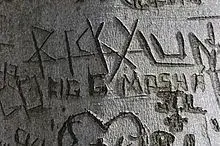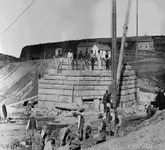L.C. BAKER
Silver Member
- Joined
- Sep 9, 2012
- Messages
- 3,805
- Reaction score
- 4,644
- Golden Thread
- 0
- Location
- Nebraska City, Nebraska
- Primary Interest:
- Other
- #1
Thread Owner
The southern beeches (Nothofagus genus) previously thought closely related to beeches, are now treated as members of a separate family, Nothofagaceae. They are found in Australia, New Zealand, New Guinea, New Caledonia, Argentina and Chile (principally Patagonia and Tierra del Fuego).
LIFE EXPECTANCY = Beech wood is an excellent firewood, easily split and burning for many hours with bright but calm flames. Chips of beech wood are used in the brewing of Budweiser beer as a fining agent. Beech logs are burned to dry the malts used in some German smoked beers, giving the beers their typical flavour. Beech is also used to smoke Westphalian ham, various sausages, and some cheeses. If they survive all of that they can live 150-200 years. Knowing that some uneducated s.o.b. could cut down the marked tree for another general purpose would make me nervous about it's long term use as a marker to a massive treasure site. it would be o.k. for a small sentinel payout perhaps some quart jars full of gold, maybe a bucket full at most. "not to mention that some passer by "oh, look somebody carved their initials in that tree....
"oh, look somebody carved their initials in that tree.... I think i will carve my initials too.. and maybe another design."
I think i will carve my initials too.. and maybe another design."

lex opaca, the American Holly, is a species of holly, native to the eastern United States, from coastal Massachusetts south to central Florida, and west to southeastern Missouri and eastern Texas average life span 150 years. if it lives. Subject to the same abuse as the Beech.
This leads me to believe, that logically, the major caches repositories and depositories will be marked by permanent structure that will last forever.
think about it and let me know what you think, L.C. baker
LIFE EXPECTANCY = Beech wood is an excellent firewood, easily split and burning for many hours with bright but calm flames. Chips of beech wood are used in the brewing of Budweiser beer as a fining agent. Beech logs are burned to dry the malts used in some German smoked beers, giving the beers their typical flavour. Beech is also used to smoke Westphalian ham, various sausages, and some cheeses. If they survive all of that they can live 150-200 years. Knowing that some uneducated s.o.b. could cut down the marked tree for another general purpose would make me nervous about it's long term use as a marker to a massive treasure site. it would be o.k. for a small sentinel payout perhaps some quart jars full of gold, maybe a bucket full at most. "not to mention that some passer by
 "oh, look somebody carved their initials in that tree....
"oh, look somebody carved their initials in that tree....
lex opaca, the American Holly, is a species of holly, native to the eastern United States, from coastal Massachusetts south to central Florida, and west to southeastern Missouri and eastern Texas average life span 150 years. if it lives. Subject to the same abuse as the Beech.
This leads me to believe, that logically, the major caches repositories and depositories will be marked by permanent structure that will last forever.
think about it and let me know what you think, L.C. baker




 ??
??

 We have come so far it was getting hard to recall the things that i used to know by heart about this trail. What with years of information that we had compiled, and some of it that we later proved to be wrong, and then the new correct information that we found out, It was mind boggling to say the least. I started from the beginning and wrote it out like a story to myself so I could keep track. Thanks to you and all of the others that have helped me along the way.
We have come so far it was getting hard to recall the things that i used to know by heart about this trail. What with years of information that we had compiled, and some of it that we later proved to be wrong, and then the new correct information that we found out, It was mind boggling to say the least. I started from the beginning and wrote it out like a story to myself so I could keep track. Thanks to you and all of the others that have helped me along the way.